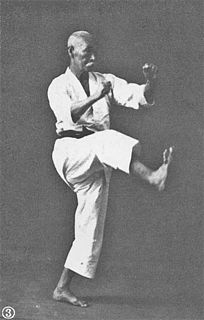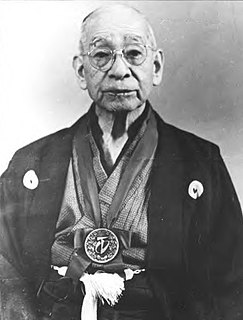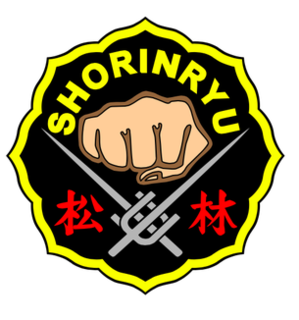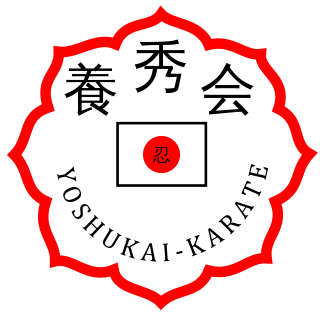Karate terms come almost entirely from Japanese. The following terms are not exclusive to karate. They appear during its study and practice, varying depending on style and school.
Karate terms include:
Osu

Karate (空手) is a martial art developed in the Ryukyu Kingdom. It developed from the indigenous Ryukyuan martial arts under the influence of Chinese martial arts, particularly Fujian White Crane. Karate is now predominantly a striking art using punching, kicking, knee strikes, elbow strikes and open-hand techniques such as knife-hands, spear-hands and palm-heel strikes. Historically, and in some modern styles, grappling, throws, joint locks, restraints and vital-point strikes are also taught. A karate practitioner is called a karateka (空手家).

Gōjū-ryū (剛柔流), Japanese for "hard-soft style", is one of the main traditional Okinawan styles of karate, featuring a combination of hard and soft techniques. Both principles, hard and soft, come from the famous martial arts book used by Okinawan masters during the 19th and 20th centuries, the Bubishi. Gō, which means hard, refers to closed hand techniques or straight linear attacks; jū, which means soft, refers to open hand techniques and circular movements. Gōjū-ryū incorporates both circular and linear movements into its curriculum, combining hard striking attacks such as kicks and close hand punches with softer open hand circular techniques for attacking, blocking, and controlling the opponent, including joint locks, grappling, takedowns, and throws.

Uechi-Ryū is a traditional style of Okinawan karate. Uechi-Ryū means "Style of Uechi" or "School of Uechi". Originally called Pangai-noon, which translates to English as "half-hard, half-soft", the style was renamed Uechi-Ryū after the founder of the style, Kanbun Uechi, an Okinawan who went to Fuzhou in Fujian Province, China to study martial arts and Chinese medicine when he was 19 years old.

Wadō-ryū (和道流) is one of the four major karate styles and was founded by Hironori Otsuka (1892–1982). The style itself places emphasis on not only striking, but tai sabaki, joint locks and throws. It has its origins within Tomari-te karate, but was also influenced by Shito-Ryu and Shotokan; and was also influenced by Ju-jitsu.
Isshin-Ryū is a style of Okinawan karate founded by Tatsuo Shimabuku in 1956. Isshin-Ryū karate is largely a synthesis of Shorin-ryū karate, Gojū-ryū karate, and kobudō. The name means, literally, "one heart method". In 1989 there were 336 branches of Isshin-ryū throughout the world, most of which were concentrated in the United States.

Shōrin-ryū (少林流) is one of the major modern Okinawan martial arts and is one of the oldest styles of karate. It was named by Choshin Chibana in 1933, but the system itself is much older. The characters 少林, meaning "sparse" or "scanty" and "forest" respectively and pronounced "shōrin" in Japanese, are also used in the Chinese and Japanese words for Shaolin. "Ryū" means "school". Shōrin-ryū combines elements of the traditional Okinawan fighting styles of Shuri-te.

Matsubayashi-Ryū (松林流), is a style of Okinawan karate founded in 1947 by Shōshin Nagamine (1907–1997). Its curriculum includes 18 kata, seven two-man yakusoku kumite routines, and kobudō (weapons) practice.

Shōrei-ryū is a style of Okinawan karate and is one of the two oldest karate styles, alongside Shōrin-ryū. It was developed at the end of the 19th century by Higaonna Kanryō in Naha, Okinawa.
Wankan (王冠) is a kata practiced in many styles of Karate. Not much is known about the history of this kata. It originates from the Tomari-te school and in modern karate is practiced in Shorin-ryu, Shito-ryu, Shotokan, Genseiryu and Matsubayashi-ryu.
Chinte (珍手) is a kata practiced in Shotokan, Shito-ryu and in Okinawan Shorin-ryu Kyudokan. It is a very old kata originating from China. Its mixture of standard movements and rarely seen techniques, vestiges of ancient forms, give this kata a special appeal. Particularly dynamic, with its alternating strong and slow passages, Chinte is unique also in the presence of a number of circular techniques, despite the preference in Shotokan karate for linear movements. It is a kata of close-distance self-defense techniques. The somewhat peculiar closing movements allude to the absorption of the power of the waves by the sand, which is a symbol of the return to tranquility after the violent storm.
Nijūshiho or NiseishiNandan sho (二十四歩) is an advanced kata practiced in Shotokan, Shitō-ryū, Chito-ryu, Ryūei-ryū Shuri-ryū and Wadō-ryū karate.
Bunkai (分解), literally meaning "analysis" or "disassembly", "is a term used in Japanese martial arts referring to process of analysing kata and extracting fighting techniques from the movements of a 'form' (kata). The extracted fighting techniques are called Oyo."

Chitō-ryū (千唐流) is a style of karate founded by Dr. Tsuyoshi Chitose, (1898-1984). The name of the style translates as: chi (千) - 1,000; tō (唐) - China; ryū (流) - style, school, "1,000 year old Chinese style." The character tō (唐) refers to the Tang Dynasty of China. The style was officially founded in 1946.
Chintō (鎮東) is an advanced kata practiced in many styles of karate. According to legend, it is named after a stranded Chinese sailor, sometimes referred to as Annan, whose ship crashed on the Okinawan coast. To survive, Chintō kept stealing from the crops of the local people. Matsumura Sōkon, a Karate master and chief bodyguard to the Ryūkyūan king, was sent to defeat Chintō. In the ensuing fight, however, Matsumura found himself equally matched by the stranger, and consequently sought to learn his techniques.
Rōhai (鷺牌) meaning “image of a heron” or “sign of a heron” is a family of kata practiced in some styles of karate. The kata originated from the Tomari-te school of Okinawan martial arts. It was called Matsumora Rōhai, after Kosaku Matsumora, who was presumably its inventor. Ankō Itosu later took this kata and developed three kata from it: Rōhai shodan, Rōhai nidan, and Rōhai sandan. In Shorin-ryū and Matsubayashi-ryū this kata introduces Gedan Shotei Ate and Ippon Ashi Dachi. It contains a sequence of Tomoe Zuki exactly the same as the one in Bassai, although the ending of the sequence chains into Hangetsu Geri/Uke.
Fukyugata is the name of a kata practiced in many styles of Okinawan karate, particularly in the Matsubayashi-ryu school of Shorin-ryu, as well as Goju-ryu, where they are termed Gekisai.

Motobu-ryū (本部流) is a school of karate founded by Choki Motobu in 1922. The official full name is Nihon Denryu Heiho Motobu Kenpo.

Yoshukai karate is a branch discipline of the Japanese/Okinawan martial art, Karate–dō, or "Way of the Empty Hand." The three kanji that make up the word Yoshukai literally translated mean "Training Hall of Continued Improvement." However, the standardized English translation is "Striving for Excellence." Yoshukai Karate has been featured in Black Belt Magazine.
Seiunchin (制引戦) is a kaishu kata of Goju-ryu karate. It was taught by Goju-ryu's founder, Chojun Miyagi, who in turn learned it from his teacher, Kanryo Higaonna. Seiunchin can be interpreted to mean "pulling".
The Iran Karate Federation (IKF) is the national body for Karate in Iran. This federation is the governing body of control and free styles of karate in Iran. It's the only association authorized to send Iranian Karatekas to the Summer Olympics.